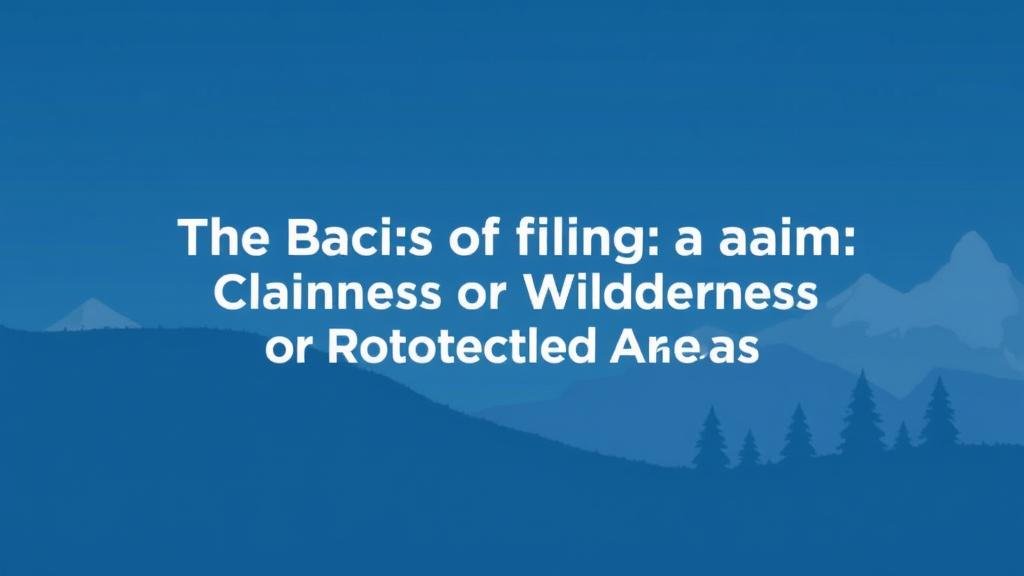The Basics of Filing a Claim in Wilderness or Protected Areas
The Basics of Filing a Claim in Wilderness or Protected Areas
Filing a claim in wilderness or protected areas is often necessary for individuals or businesses seeking compensation for damages or losses incurred while engaging in activities within these special landscapes. Understanding the nuances of this process is crucial, given the unique regulatory framework that governs these areas. This article provides a comprehensive overview of the necessary steps, regulations, and best practices involved in filing such claims.
Understanding Wilderness and Protected Areas
Wilderness areas and protected lands are designated by government entities for conservation, recreation, and the preservation of unique ecological systems. e areas are often subject to stringent regulations to minimize human impact. Examples include:
- The National Wilderness Preservation System in the United States.
- National Parks, such as Yellowstone and Yosemite.
- Wildlife refuges and marine protected areas.
Potential Claims in Wilderness Areas
Individuals may encounter a variety of situations that warrant filing a claim in wilderness or protected areas. Common claims include:
- Property damage due to natural disasters, such as wildfires or floods.
- Injuries incurred from accidents or encounters with wildlife.
- Losses related to environmental regulations prohibiting harvest of natural resources.
The Claims Process
The process of filing a claim typically involves several key steps, which include documentation, reporting, and submission. Below are the critical elements to navigate this process effectively:
1. Documenting the Incident
Immediate documentation is essential. Take photographs, gather witness statements, and keep records of dates, times, and specifics surrounding the incident. For example, if a hiking trail has been blocked due to a fallen tree, capturing the scene can significantly bolster your case.
2. Understanding Applicable Regulations
Regulations governing claims can vary significantly between jurisdictions and types of protected areas. For example, the Federal Tort Claims Act (FTCA) dictates how claims against the federal government are handled. Review specific policies of the area in question to ascertain relevant guidelines and deadlines.
3. Reporting the Claim
Once documentation is complete, contact the appropriate managing agency. For example, the National Park Service manages most national parks, while the U.S. Forest Service oversees national forests. Submitting a complaint in writing often initiates the claims process.
4. Submitting Your Claim
Craft a clear and concise claim submission that includes:
- A detailed narrative of the incident.
- All supporting documentation (photographs, reports, etc.).
- Your contact information and any relevant insurance details.
Real-World Applications
To illustrate the process, consider the case of a tourist who sustained an injury after tripping on an unmarked trail in a national park. After documenting the incident with photographs and a medical report, the individual contacted the National Park Service. By following the reporting procedures outlined by the agency and submitting a complete claim with all supporting documents, the tourist successfully received compensation for medical expenses.
Important Considerations
Before proceeding with a claim, be mindful of the following:
- Deadlines for filing claims can vary; failing to meet these can result in the dismissal of your claim.
- Engaging legal counsel experienced in environmental law may enhance your chances of a successful claim.
- Consider the potential for alternative dispute resolution methods, such as mediation, which may expedite the process.
Conclusion and Actionable Takeaways
Filing a claim in wilderness or protected areas can be a complex process fraught with regulations and bureaucratic challenges. To navigate this terrain effectively:
- Document incidents meticulously.
- Understand the specific regulations governing the area.
- Engage with the appropriate managing agency promptly.
By following these guidelines and staying informed, claimants can improve their chances of a successful outcome and help ensure that fairness and accountability are upheld within these vital natural spaces.



